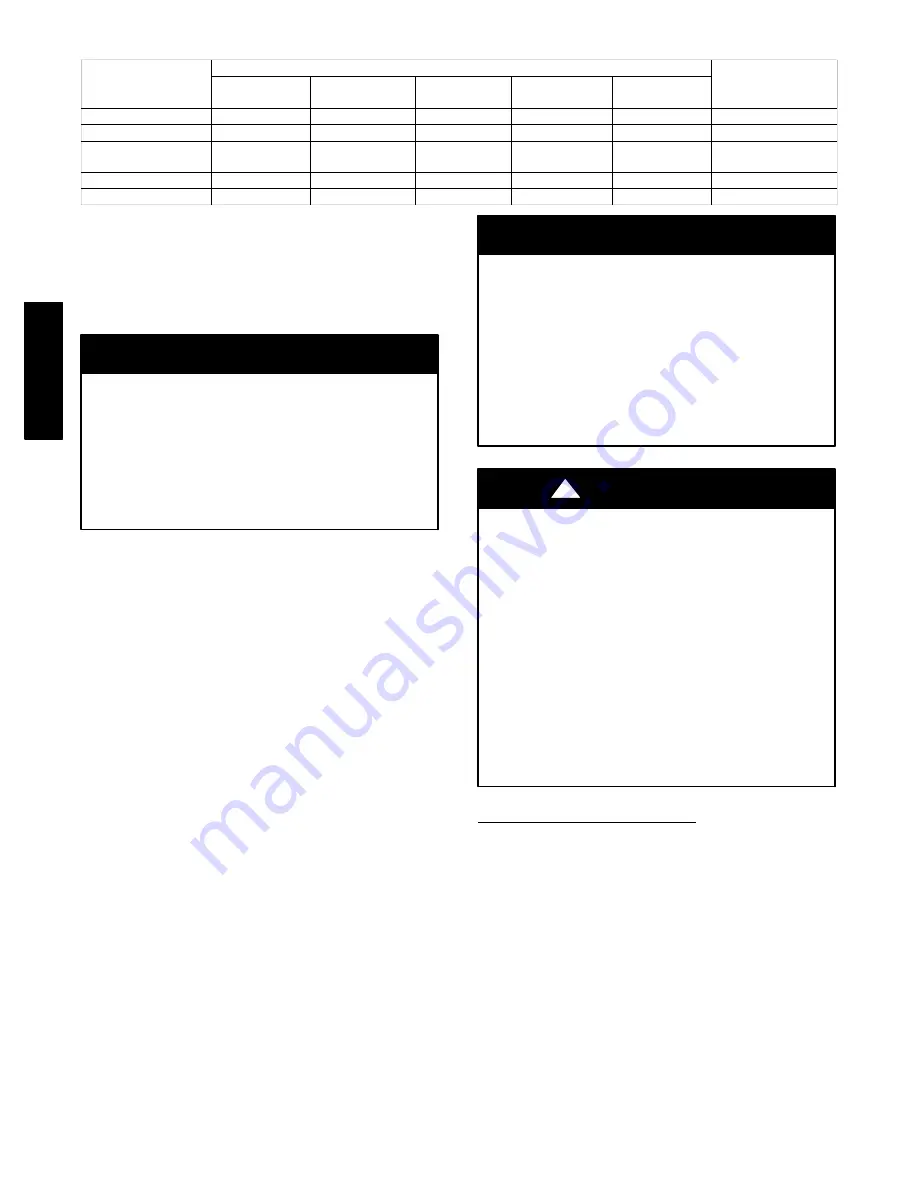
42
Table 13 – Vent Termination Kit for Direct Vent (2
−
pipe) Systems
Vent and
Combustion Air
Pipe Diameters
Approved Two
−
Pipe Termination Fittings
Allowable
Concentric Vent
Kit
1 1/2
−
in.
(38 mm)
2
−
in.
(51 mm)
2 1/2
−
in.
(64 mm)
3
−
in.
(76
−
mm)
4
−
in.
(102 mm)
1 1/2
−
in. (38 mm)
No
Yes
No
No
No
2
−
in. (51 mm)
2
−
in. (51 mm)
No
Yes
No
No
No
2
−
in. (51 mm)
2 1/2
−
in. (64 mm)
No
No
No
Yes
No
2
−
in. (51 mm)
3
−
in. (76 mm)
3
−
in. (76
−
mm)
No
No
No
Yes
No
3
−
in. (76 mm)
4
−
in. (102 mm)
No
No
No
Yes
Yes
3
−
in. (76 mm)
Direct Vent / 2-Pipe System
In a direct-vent (2-pipe) system, all air for combustion is taken
directly from outdoor atmosphere, and all flue products are
discharged to outdoor atmosphere. Combustion-air and vent pipes
must terminate together in the same atmospheric pressure zone,
either through the roof (preferred) or a sidewall. See Fig. 52 for
references to clearances required by National code authorities.
OPTIONAL CONFIGURATION FOR COMBUSTION
AIR INLET PIPE
In applications where there is a risk of excessive moisture
entering the combustion air inlet pipe, a moisture trap may be
added to the inlet pipe to help prevent moisture from entering
the furnace from the combustion air inlet pipe. See Fig. 59.
When sizing venting systems, the equivalent length of the
optional inlet pipe moisture trap must be taken into account.
NOTICE
Ventilated Combustion Air Systems
In a ventilated combustion air option, the vent terminates and
discharges the flue products directly to the outdoors similar to a
direct vent system. See Fig. 53 for references to clearances required
by National code authorities.
All air for combustion is piped directly to the furnace from a space
that is well ventilated with outdoor air (such as an attic or crawl
space) and the space is well isolated from the living space or
garage. Combustion air requirements for this option are the same as
the requirements for providing outside air for combustion for a
single pipe vent system. Refer to the “Air For Combustion and
Ventilation” Section.
Non-Direct Vent (1-pipe) System
In a non direct-vent (1-pipe) system, all air for combustion is taken
from the area adjacent to furnace, and all flue products are
discharged to outdoor atmosphere. Air for combustion must be
supplied as described in the Air For Combustion and Ventilation
Section. Do not use an abandoned chimney to supply outside air to
the furnace. See Fig. 53 for references to vent clearances required
by National code authorities.
A combustion air pipe to the outdoors is not required for a
single
−
pipe vent system. A 12-in. (304 mm) long pipe with a 2
−
in.
(51 mm) tight radius 90 degree elbow is
required
to be attached to
the combustion air pipe adapter on the furnace. See Fig. 56. This
short inlet air pipe helps to ensure stable combustion, as well as
allow for sound attenuation. To aid sound attenuation, point the
inlet air pipe away from occupants. An extra elbow and/or five
feet of pipe may be used to accomplish the sound attenuation
function.
OPTIONAL VENTING BELOW THE FURNACE
The venting system may be positioned below the furnace
ONLY
IF the factory accessory External Vent Trap Kit is used.
The External Vent Trap Kit is only approved for PVC/ABS
DWV venting systems.
CAREFULLY FOLLOW THE INSTRUCTIONS
PROVIDED WITH THE EXTERNAL VENT TRAP KIT
FOR LAYING OUT THE VENTING SYSTEM AND
THE DRAIN SYSTEM.
The instructions included with this
furnace
DO NOT APPLY
to vent systems that are located
below the furnace.
NOTICE
CARBON MONOXIDE POISONING HAZARD
Failure to follow the instructions outlined below for each
appliance being placed into operation could result in carbon
monoxide poisoning or death.
The instructions included with this furnace
DO NOT APPLY
to vent systems that are located below the furnace.
CAREFULLY FOLLOW THE INSTRUCTIONS
PROVIDED WITH THE EXTERNAL VENT TRAP KIT
FOR LAYING OUT THE VENTING SYSTEM AND
THE DRAIN SYSTEM
when all or part of the venting
system is placed below the furnace.
Proper configuration of the venting and drain system is critical
when placing all or part of the venting system below the level
of the furnace.
VENT GASSES COULD BE RELEASED
FROM THE DRAINAGE SYSTEM
if the instructions
provided with the External Vent Trap Kit are not followed.
!
WARNING
Locating the Vent Termination
General
NOTE
:
Termination Requirements for the Provinces of
Alberta and Saskatchewan are located at the end of this
section.
Combustion
−
air inlet pipe (direct vent/2
−
pipe system only) and
vent pipe must terminate outside structure, either through sidewall
or roof.
For vent termination clearance, references to National codes are
shown in Fig. 52 for Direct Vent/2
−
Pipe system and Fig. 53 for
Ventilated Combustion Air/Non
−
direct Vent/1
−
Pipe system. For
exterior termination arrangements, refer to Fig. 54 for Direct
Vent/2
−
Pipe system and Fig. 55 for Ventilated Combustion
Air/Non
−
Direct/1
−
Pipe system. Contact Local code authorities for
other requirements to and/or exemptions from the National codes
shown in the figures.
Roof termination is the recommended termination location. Roof
terminations provide better performance against sustained
PG92S*S













































